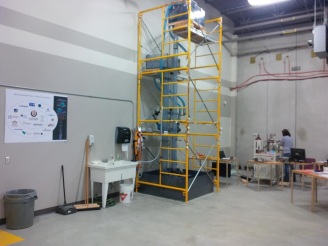Half the HAC Pack are currently operating from the HAC Lab at Cambrian College. This shot shows the pilot “Baby HAC” in an operating, instrumented condition alongside the mass spectrometer instrument. The mass spectrometer provides real time analysis of the compressed gas chemistry. The ‘Achilles Heel’ of the HAC is the fact that because the gas is compressed using water, some of the gas dissolves in the water and by-passes the physical separation device (the grey tank at the bottom). We have come up with a simple solution to this problem: use of co-solutes to control the gas solubility. The major benefit of a machine that compresses the gas with water is that the water simultaneously cools the gas so that the compression process is isothermal – the most energy efficient gas compression process conceivable! Although we haven’t been here long, we have already entertained many visitors at HAC Lab, including Ontario’s Energy Minister and Sudbury’s MPP, Glenn Thiabault and a certain Dominic Giroux who got a 5 minute lecture on advanced thermo-fluid mechanics while watching the machine in operation.

Based on a design we think was prepared by Charles Havelock Taylor himself, Valeria (mostly) and Alex (latterly) designed Baby HAC in transparent polycarbonate so we could actually see the air/water mixing, downcomer compression process, and compressed air/water separation processes – as they happen. Alex has now fully instrumented the Baby HAC and is using it to optimise air/water mixing head geometries, in doing this, Alex has become our LabView guru. Valeria is using Baby HAC to test out a novel 2 phase flow gas-water sampling system that passes a controlled flow rate of sample gas to Caterina’s real time gas analyser mass spectrometer (Caterina, and the mass spectrometer are visible to the rear right in the photo).

Baby HAC at Discovery 2016, Toronto
We study the academic literature, and in it, while there are numerous descriptions of the geometry of HACs, and there are a fair number of (historical) articles on the performance of HACs, there is very little written about how they were controlled in practice. It was only by building Baby HAC that we found out the simplest way to do it – a HAC secret over a century old.
The best historical technical source to find out about the details of HACs is the monograph by Leroy Schulz, prepared in 1950: Schulze, L., 1954. Hydraulic Air Compressors, Bureau of Mines, Information Circular 7683.
If you would like to buy your own Baby HAC, let us know by completing an enquiry form. Seeing a HAC in operation yourself is simply a beautiful thing. We will send you details of our design, handle all of the procurement, package and ship it with instructions of i) how to fill it up, ii) turn it on and iii) turn it off. After that, you plug it in and you can conduct your own experiments. We will charge you 25% on top of our cost price, with evidence of our costs, plus packaging and shipping. We need to charge a bit extra to keep the project and our start up business going. We warn you in advance: you will need a space with at least 5m of headroom to put Baby HAC up.